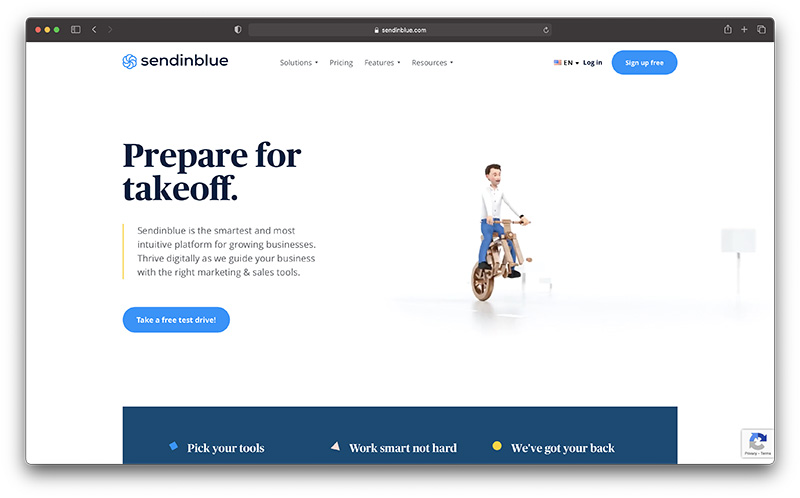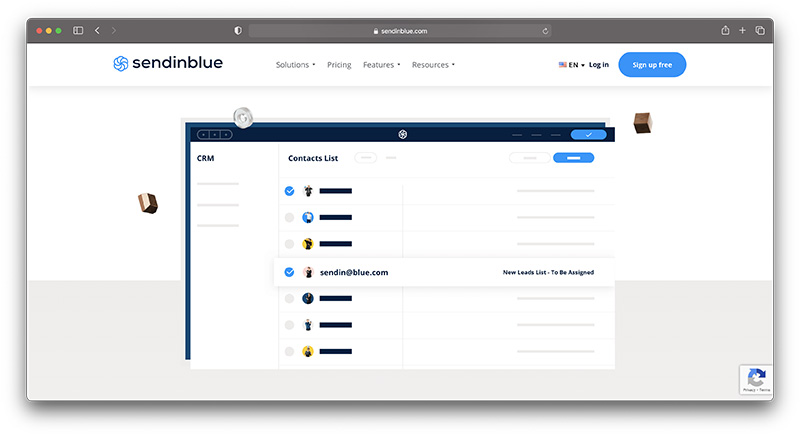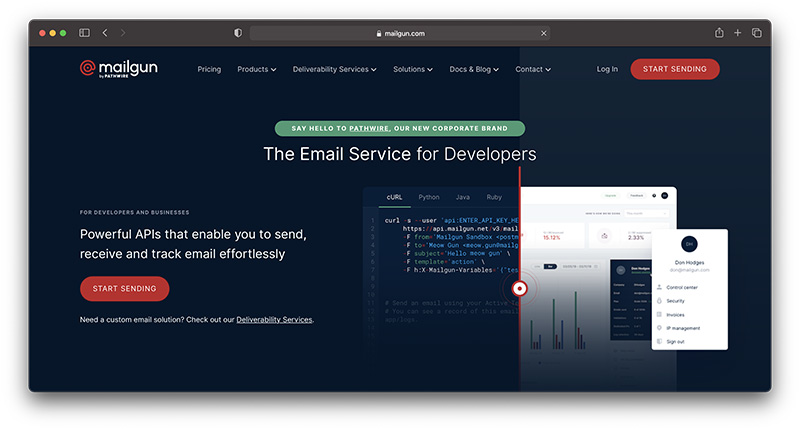It’s no secret that email marketing is one of the most valuable and effective ways to connect with your target audience. With more than half of the world relying on their email to keep in touch with brands and other people, the inbox is a valuable place to be.
The question for today’s business leaders is how they can choose the right email marketing solution for their needs. With so many solutions out there for transactional email, marketing automation, and more, it’s tough to make an informed choice.
Today, we’re going to be exploring the benefits of two very different email marketing tools, with incredible functionality to offer. Here’s your guide to Sendinblue vs Mailgun.
Sendinblue vs Mailgun: The Basics
Sendinblue and Mailgun are two very different tools.
Sendinblue started as a standard email marketing tool, but over the years it gained more features, allowing customers to access everything from API integrations, to SMS marketing and live chat. Sendinblue even has its own CRM functionality so you can manage your connections with customers however you choose.
 On the other hand, Mailgun allows companies to send transactional emails from an existing application in their business. In other words, you can use SMTP endpoints or APIs to add email functionality into your CMS or another tool. Once you’ve added the email functionality into your existing service, you can customize and deliver all kinds of email marketing campaigns and transactional emails.
On the other hand, Mailgun allows companies to send transactional emails from an existing application in their business. In other words, you can use SMTP endpoints or APIs to add email functionality into your CMS or another tool. Once you’ve added the email functionality into your existing service, you can customize and deliver all kinds of email marketing campaigns and transactional emails.
The biggest difference between the two tools is their target audience. Mailgun is aimed at developers, and it’s built specifically with the tech-savvy audience in mind. If you’re not a developer and don’t know a lot about email coding, this may not be the right tool for you. On the other hand, Sendinblue intends to give you everything you need out of the box.
For complete beginners and developers alike, Sendinblue offers a flexible way to access everything from API access, to SMTP server functionality and a host of additional add-on features.
Sendinblue vs Mailgun: Pricing
Pricing is one of the most important concerns for people choosing between products like Sendinblue.com, and Mailgun. It doesn’t matter whether you’re using Postmark, Mandrill, or something else entirely, you’ll still want an affordable pay-as-you-go pricing strategy, or monthly payment schedule.
Sendinblue starts off well with its pricing structure, offering a free plan that allows you to send 300 emails per day to unlimited numbers of contacts. If you upgrade to a paid package, you can choose:
- Lite: between $22.50 and $25 per month (paid annually or monthly): This package comes with unlimited contact support and no daily sending limit. You can only send up to 40,000 emails per month, however.
- Essential: between $35.10 and $39 per month (paid annually or monthly): This plan comes with all the features of Lite, plus no Sendinblue branding for your emails. You can send up to 60,000 emails per month.
- Premium: between $59.50 and $66 per month (paid annually or monthly): This package features everything from the Essential plan, plus marketing automation, multi-user access, live chat functionality, landing pages, and social media Facebook ads.
There’s an Enterprise plan available which is priced based on your specific needs. You get a dedicated account manager and priority support with this account, alongside all the features of Premium.
Mailgun’s pricing is a little different. The options available include:
- Flex: Free for the first 3 months, then pay-as-you-go: 5,000 emails per month, $0.80 per email, Powerful email API access, webhook forwarders, SMTP relay, email tracking, and analytics, detailed documentation, ticket support, and searchable logs for 5 days.
- Foundation: Between $35 and $75 per month: This package gives you everything you got from the previous Flex plan, as well as support for sending up to 100,000 emails per month, inbound email routing, and a dedicated IP. You also get 1 day of message retention, inbox placement, email validation, and 24/7 support.
- Growth: Between $80 and $650 per month. This comes with everything in the foundation plan, support for up to 1,000,000 emails, as well as searchable logs for up to 15 days. You get one dedicated IP, 1,000 email validations, message retention for 3 days, 10 placement tests, and live chat support,
- Scale: Between $90 and $1,250 per month. With this package, you get all the features of Growth, plus 1 dedicated IP address, support for up to 2.5 million emails a month, instant chat support, 5,000 email validations, 15 placement tests, send-time optimization, searchable logs for up to 30 days, and live phone support.
- Enterprise: Custom pricing for bigger companies. This plan gives you everything in scale, support for over 2.5 million emails a month, deliverability services, real-time guidance, custom features, and rapid-fire sending.
Sendinblue vs Mailgun: Email Marketing Functionality
To help you fully understand the benefits of both Sendinblue and Mailgun, let’s start by exploring what each tool can offer in the way of features. Both of these solutions are designed for email marketing, but they approach it in different ways.
Sendinblue has email marketing at it’s heart, with other features linking to it. The email marketing feature available from Sendinblue is all about simplicity and deliverability. You don’t have to worry about the stress of email delivery to a larger audience, as Sendinblue helps you to reach everyone with the right content through immersive segmentation.
There are tons of great templates to choose from that are designed to make your business stand out, and A/B testing to track the performance of different marketing campaigns. On top of that, Sendinblue allows you to link your email marketing efforts to other marketing campaigns through social media and SMS too. There’s even a live chat support functionality.
21i9The built-in CRM from Sendinblue makes it much easier to create a more custom and relevant set of emails for the list of contacts you most want to reach. You can use this email service for everything from fully automated trigger campaigns, to transactional emails.
 In fact, Sendinblue is very well-known for it’s transactional campaigns, which come with payment validation, order validation, invoices, receipts, shipping orders, refunding, order completion and more.
In fact, Sendinblue is very well-known for it’s transactional campaigns, which come with payment validation, order validation, invoices, receipts, shipping orders, refunding, order completion and more.
Where Sendinblue piles everything you need for effective email marketing into the same solution, Mailgun is all about giving you flexibility with your tools. If you’re looking for a way to add email marketing to the existing CRM and CMS solutions that you have today, then Mailgun is an ideal choice.
Mailgun is an email service that’s specifically created for software developers looking for an API to send emails to their audience. The API is the tool that gives applications and websites further access to the functionality they’re looking for from an email marketing solution. Mailgun is great for plain transactional emails, but there are some limitations in what you can customize. The more you know about Html, the better off you’ll be.
The good news is that Mailgun doesn’t just offer API features and nothing else. Once you’ve installed Mailgun into your WordPress website, or whatever other CMS you might be using, you can also access things like email validation, A/B testing, deliverability optimization and burst sending.
The most attractive feature that Mailgun can offer is it’s SMTP email protocol, which helps with sending emails online. This protocol helps users to bypass the common sending limits associated with clients like Gmail and Outlook. For instance, if you used Gmail for your email client, you would only be able to send up to 2,000 emails per day.
When you have an extensive email list, this sending quota can be a little limiting. Investing in tools like Mailgun significantly benefit your business.
Sendinblue vs Mailgun: Design and Templates
Email templates can be an important consideration for a small business in search of the perfect marketing tool. The design options you can access will dictate what kind of impression you can make on your target audience. Sendinblue comes with arrange of fantastic templates to choose from to get you started, or you can design your email from scratch.
Thanks to a drag-and-drop email editor, you don’t have to waste a lot of time learning how to use different tools to make your emails look good. There are more than 70 email templates already designed to give you a great start, and you can add your own elements depending on your needs.
Personalizing your email isn’t a tough process here. All you need to do is drag and drop elements that you want to have into your messages, changing the sizes and uploading different elements when you choose. There’s no need for any extensive technical knowledge.
Of course, for developers, this could mean that your email marketing service simply isn’t flexible enough. Mailgun is a mail API and SMTP tool, rather than a full email automation service. If you’re looking for an email marketing service that gives you everything at once, then Mailgun isn’t what you need.
Instead, Mailgun is a transactional email solution that’s intended for developers and IT experts who want to send and receive emails. You can easily monitor the performance of your emails with this tool and optimize them to achieve better results too.
Notably, there’s complete access to the API here, so you can edit and code your emails however you choose. However, unless you have a lot of developer knowledge, you’ll probably struggle to get anything much out of the Mailgun platform. Remember, this service is specifically designed for people who know programming languages like Ruby, Java, and Python.
For the most part, Mailgun seems to be more suited for people who want to send quite plain and simple email messages.
Sendinblue vs Mailgun: Automation
Sendinblue and Mailgun are very different experiences when it comes to automation and connecting consistently with your audience. Sendinblue has a vast range of tools for segmentation, including a built-in CRM that will help you to make the most out of your grouping solution for your contacts. There’s an automated editor to manage the workflow of your emails too.
Sendinblue is all about making email marketing easy, and that shows in its approach to automation. Beginners and experienced users will be able to take advantage of it’s in-built workflow templates, which offer a better insight into the basics of automation than you’d get from solutions like MailChimp. The completed workflows mean you just have to make basic changes based on whether you’re sending a customer support email, or a welcome email system.
Unfortunately, there are some limitations here. Automated workflows aren’t the most advanced feature on Sendinblue. If you want to get more advanced, you might want to look into GetResponse or ActiveCampaign.
Some things are harder to compare with Sendinblue and Mailgun than others. For instance, we can easily look at things like email deliverability, and whether you get a dedicated IP address, but automation doesn’t work the same for every service.
When it comes to battling Mailgun vs Sendinblue, it’s worth noting that Mailgun isn’t a full automation system. Mailgun is a transactional email solution, which allows you to send automated one-to-one emails generated by specific events. In other words, you can send a message to someone when they buy a product from you.
In that regard, Mailgun has basic automation options. However, you can’t send a number of emails in a series to help your marketers connect with customers or generate engagement after people land on your landing pages. Mailgun is all about the transactional messages.
You can access features like intelligent routing and forwarding, scheduled delivering, and bounced message handling, but that’s about it. Mailgun also has a handy email validation feature, so you can check whether your email is likely to bounce before you send it.
One thing you could also possibly define as “automation” with Mailgun is it’s burst sending feature. If you need to send a mass email to thousands of people at once, without being held back by service providers like Gmail, Mailgun has you covered. You can send transactional emails out to subscribers rapidly with the burst fire feature, There’s even the option to choose exactly when those messages go out.
Unfortunately, you won’t find any WYSIWYG automation or workflow builders here.
Sendinblue vs Mailgun: Verdict
Choosing the right solution for your email marketing can be tough. There are so many companies out there offering free emails, plugins, PHP support, and more to help you get started. Whether you’re looking for bulk emails and webhooks, or a simple solution with pay-as-you-go functionality, it’s tough to make the right choice.
Browsing through the reviews available online with screenshots can help you to see the features of things like Sendgrid, Mailjet, and sparkpost, but some solutions are more difficult to compare than others.
Mailgun and Sendinblue are very different email services. While Mailgun is all about transactional emails and intelligent routing, Sendinblue helps you to built more complete email campaigns from scratch. Mailgun seems to be a solution specifically for web developers and coding professionals, while Sendinblue gives you everything you need straight of the box.
You can access email and SMS marketing, marketing automation, detailed analytics, a customer relationship management service, and even support for GDPR compliance. Although there’s not as much support for coding manipulation on Sendinblue, that’s unlikely to be a problem for many new businesses trying to get started online.
Which email marketing service do you think you’ll be using?





Comments 0 Responses